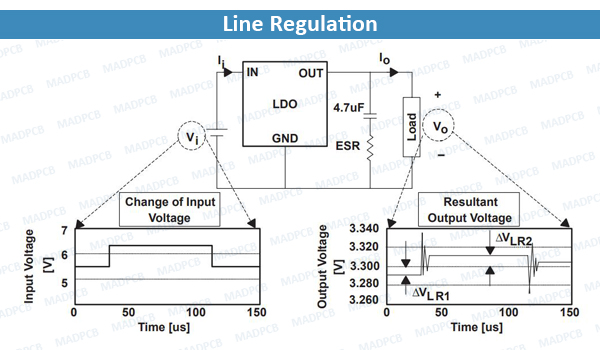What is Line Regulation?
Line Regulation is the ability of a power supply to maintain a constant output voltage (Vo) despite changes to the input voltage (Vi), with the output current drawn from the power supply remaining constant.
Line Regulation = ΔVo/ΔVi x 100%
where ΔVi is the change in input voltage while ΔVo is the corresponding change in output voltage.
It is desirable for a power supply to maintain a stable output regardless of changes in the input voltage. It is important when the input voltage source is unstable or unregulated and this would result in significant variations in the output voltage. It for an unregulated power supply is usually very high for a majority of operations, but this can be improved by using a voltage regulator. A low line regulation is always preferred. In practice, a well-regulated power supply should have a line regulation of at most 0.1%.
In the regulator device datasheets, it is expressed as percent change in output with respect to change in input per volt of the output. Mathematically it is expressed as:
Line Regulation = ΔVo/(ΔVi · Vo) x 100%/V
The unit here is %/V. For example, S1206-series regulator device, the typical is expressed as 0.05%/V which means that the change in the output with respect to change in the input of the regulator device is 0.05%, when the output of the device is set at 1V. Moreover, the line regulation of the device expressed in the datasheet is temperature dependent. Usually, the datasheets mention it at 25°C.
A power supply with tight line regulation delivers optimum voltages throughout the operating range.
Input Voltage Variation (ΔVi):
4.2V – 3V = 1.2V
Output Voltage Variation (ΔVo):
Based on its characteristic, ΔVOUT is determined by the following formula:
| Typical | 0.02%/V × 1.2 V = 0.024% | 1.8 V × 0.024% = 0.432 mV |
| Max | 0.10%/V × 1.2 V = 0.12% | 1.8 V × 0.12% = 2.16 mV |
In short, by the input voltage difference between 3V and 4.2 V, the 1.8V output changes by typically 0.432mV / maximum 2.16 mV. The output voltage may be affected both positively and negatively.
While the majority of DC power supplies convert AC from the mains to the DC output voltage required, there are some DC power supplies that rely on other auxiliary power sources to provide additional power for the power supply to achieve the required output. It is usually specified for power supplies that use the auxiliary power and may not be specified for the standard supplies that rely solely on the single mains supply source.
In voltage regulators such as the Low Dropout Output (LDOs), the manufacturers provide two specifications in regard to the regulation; the line regulation and the power-supply rejection ratio (PSRR).
The line regulation shows the ability of the LDO to maintain its output regardless of changes in its input voltage.

Line Regulation
The figure shows a typical response of the TPS76933 3.3 Volts LDO. If the input voltage to the regulator changes, the resulting output voltage will change and have different values at different input voltages. It is calculated from the ΔVLR1 and ΔVLR2. The parameter is usually a steady state parameter, which is a measure of the regulator’s open loop gain; with all the frequency components neglected. (i.e. at zero frequency). As such, it can be improved by improving the open loop gain.
